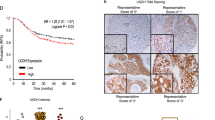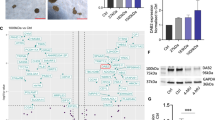Abstract
Proteoglycans and glycosaminoglycans modulate numerous cellular processes relevant to tumour progression, including cell proliferation, cell-matrix interactions, cell motility and invasive growth. Among the glycosaminoglycans with a well-documented role in tumour progression are heparan sulphate, chondroitin/dermatan sulphate and hyaluronic acid/hyaluronan. While the mode of biosynthesis differs for sulphated glycosaminoglycans, which are synthesised in the ER and Golgi compartments, and hyaluronan, which is synthesized at the plasma membrane, these polysaccharides partially compete for common substrates. In this study, we employed a siRNA knockdown approach for heparan sulphate (EXT1) and heparan/chondroitin/dermatan sulphate-biosynthetic enzymes (β4GalT7) in the aggressive human breast cancer cell line MDA-MB-231 to study the impact on cell behaviour and hyaluronan biosynthesis. Knockdown of β4GalT7 expression resulted in a decrease in cell viability, motility and adhesion to fibronectin, while these parameters were unchanged in EXT1-silenced cells. Importantly, these changes were associated with a decreased expression of syndecan-1, decreased signalling response to HGF and an increase in the synthesis of hyaluronan, due to an upregulation of the hyaluronan synthases HAS2 and HAS3. Interestingly, EXT1-depleted cells showed a downregulation of the UDP-sugar transporter SLC35D1, whereas SLC35D2 was downregulated in β4GalT7-depleted cells, indicating an intricate regulatory network that connects all glycosaminoglycans synthesis. The results of our in vitro study suggest that a modulation of breast cancer cell behaviour via interference with heparan sulphate biosynthesis may result in a compensatory upregulation of hyaluronan biosynthesis. These findings have important implications for the development of glycosaminoglycan-targeted therapeutic approaches for malignant diseases.




Similar content being viewed by others
References
Karousou E.G. et al.: Analysis of glycosaminoglycans by electrophoretic approach. Curr. Pharm. Anal. 4(2), 78–89 (2008)
Vigetti D. et al.: Analysis of hyaluronan synthase activity. Methods Mol. Biol. 1229, 201–208 (2015)
Varki, A.: Essentials of glycobiology. (2nd ed.). Cold Spring Harbor Laboratory Press, Cold Spring Harbor, N.Y. 2009
Iozzo R.V., Schaefer L.: Proteoglycan form and function: a comprehensive nomenclature of proteoglycans. Matrix Biol. 42, 11–55 (2015)
Hediger M.A. et al.: The ABCs of solute carriers: physiological, pathological and therapeutic implications of human membrane transport proteinsIntroduction. Pflugers Arch. 447(5), 465–468 (2004)
Bernfield M. et al.: Functions of cell surface heparan sulfate proteoglycans. Annu. Rev. Biochem. 68, 729–777 (1999)
Götte M. et al.: Changes in heparan sulfate are associated with delayed wound repair, altered cell migration, adhesion and contractility in the galactosyltransferase I (beta4GalT-7) deficient form of Ehlers-Danlos syndrome. Hum. Mol. Genet. 17(7), 996–1009 (2008)
Kirkbride K.C., Ray B.N., Blobe G.C.: Cell-surface co-receptors: emerging roles in signaling and human disease. Trends Biochem. Sci. 30(11), 611–621 (2005)
Esko J.D., Selleck S.B.: Order out of chaos: assembly of ligand binding sites in heparan sulfate. Annu. Rev. Biochem. 71, 435–471 (2002)
Bülow H.E., Hobert O.: The molecular diversity of glycosaminoglycans shapes animal development. Annu. Rev. Cell Dev. Biol. 22, 375–407 (2006)
Bishop J.R., Schuksz M., Esko J.D.: Heparan sulphate proteoglycans fine-tune mammalian physiology. Nature. 446(7139), 1030–1037 (2007)
Forsberg E., Kjellén L.: Heparan sulfate: lessons from knockout mice. J. Clin. Invest. 108(2), 175–180 (2001)
Whitelock J.M., Iozzo R.V.: Heparan sulfate: a complex polymer charged with biological activity. Chem. Rev. 105(7), 2745–2764 (2005)
Sugahara K., Kitagawa H.: Recent advances in the study of the biosynthesis and functions of sulfated glycosaminoglycans. Curr. Opin. Struct. Biol. 10(5), 518–527 (2000)
Seidler D.G. et al.: Defective glycosylation of decorin and biglycan, altered collagen structure, and abnormal phenotype of the skin fibroblasts of an Ehlers-Danlos syndrome patient carrying the novel Arg270Cys substitution in galactosyltransferase I (beta4GalT-7. J Mol Med (Berl). 84(7), 583–594 (2006)
Presto J. et al.: Heparan sulfate biosynthesis enzymes EXT1 and EXT2 affect NDST1 expression and heparan sulfate sulfation. Proc. Natl. Acad. Sci. U. S. A. 105(12), 4751–4756 (2008)
Busse M. et al.: Contribution of EXT1, EXT2, and EXTL3 to heparan sulfate chain elongation. J. Biol. Chem. 282(45), 32802–32810 (2007)
Filipek-Górniok B. et al.: Expression of chondroitin/dermatan sulfate glycosyltransferases during early zebrafish development. Dev. Dyn. 242(8), 964–975 (2013)
Passi, A., et al., O-GlcNAcylation and hyaluronan synthesis. FASEB J. 26 (2012)
Vigetti D. et al.: Role of UDP-N-Acetylglucosamine (GlcNAc) and O-GlcNAcylation of hyaluronan synthase 2 in the control of chondroitin sulfate and hyaluronan synthesis. J. Biol. Chem. 287(42), 35544–35555 (2012)
Ishida N., Kawakita M.: Molecular physiology and pathology of the nucleotide sugar transporter family (SLC35. Pflugers Arch. 447(5), 768–775 (2004)
Hiraoka S. et al.: Nucleotide-sugar transporter SLC35D1 is critical to chondroitin sulfate synthesis in cartilage and skeletal development in mouse and human. Nat. Med. 13(11), 1363–1367 (2007)
Hwang H.Y., Horvitz H.R.: The Caenorhabditis elegans vulval morphogenesis gene sqv-4 encodes a UDP-glucose dehydrogenase that is temporally and spatially regulated. Proc. Natl. Acad. Sci. U. S. A. 99(22), 14224–14229 (2002)
Götte M.: Syndecans in inflammation. FASEB J. 17(6), 575–591 (2003)
Karousou, E., et al.: Collagen VI and hyaluronan: the common role in breast cancer. Biotechnol. Res. Int. 2014
Vigetti D. et al.: Epigenetics in extracellular matrix remodeling and hyaluronan metabolism. FEBS J. 281(22), 4980–4992 (2014)
Vigetti D. et al.: Hyaluronan: biosynthesis and signaling. Biochim. Biophys. Acta. 1840(8), 2452–2459 (2014)
Vigetti D. et al.: Metabolic control of hyaluronan synthases. Matrix Biol. 35, 8–13 (2014)
Multhaupt H.A. et al.: Extracellular matrix component signaling in cancer. Adv. Drug Deliv. Rev. 97, 28–40 (2016)
Soares M.A. et al.: Heparan sulfate proteoglycans may promote or inhibit cancer progression by interacting with integrins and affecting cell migration. Biomed. Res. Int. 2015, 453801 (2015)
Beauvais D.M., Rapraeger A.C.: Syndecan-1-mediated cell spreading requires signaling by alphavbeta3 integrins in human breast carcinoma cells. Exp. Cell Res. 286(2), 219–232 (2003)
Feugaing D.D.S., Goette M., Viola M.: More than matrix: the multifaceted role of decorin in cancer. Eur. J. Cell Biol. 92(1), 1–11 (2013)
Asimakopoulou A.P. et al.: The biological role of chondroitin sulfate in cancer and chondroitin-based anticancer agents. In Vivo. 22(3), 385–389 (2008)
Yamashita H. et al.: Mammalian and drosophila cells adhere to the laminin alpha4 LG4 domain through syndecans, but not glypicans. Biochem. J. 382(Pt 3), 933–943 (2004)
Vieira L.A. et al.: The alga Bryothamnion seaforthii contains carbohydrates with antinociceptive activity. Braz. J. Med. Biol. Res. 37(7), 1071–1079 (2004)
Fila G. et al.: In Vitro evaluation of dew-retting of flax by fungi from southern Europe. Ann. Appl. Biol. 138(3), 343–351 (2001)
Götte M. et al.: miR-145-dependent targeting of junctional adhesion molecule a and modulation of fascin expression are associated with reduced breast cancer cell motility and invasiveness. Oncogene. 29(50), 6569–6580 (2010)
Sempere L.F. et al.: Altered MicroRNA expression confined to specific epithelial cell subpopulations in breast cancer. Cancer Res. 67(24), 11612–11620 (2007)
Ibrahim S.A. et al.: Syndecan-1 (CD138) modulates triple-negative breast cancer stem cell properties via regulation of LRP-6 and IL-6-mediated STAT3 signaling. PLoS One. 8(12), e85737 (2013)
Götte M. et al.: An expression signature of syndecan-1 (CD138), E-cadherin and c-met is associated with factors of angiogenesis and lymphangiogenesis in ductal breast carcinoma in situ. Breast Cancer Res. 9(1), R8 (2007)
Rubin J.S. et al.: Dissociation of heparan sulfate and receptor binding domains of hepatocyte growth factor reveals that heparan sulfate-c-met interaction facilitates signaling. J. Biol. Chem. 276(35), 32977–32983 (2001)
Pasqualon T. et al.: Cell surface syndecan-1 contributes to binding and function of macrophage migration inhibitory factor (MIF) on epithelial tumor cells. Biochim. Biophys. Acta. 1863(4), 717–726 (2016)
Vigetti D. et al.: Molecular cloning and characterization of UDP-glucose dehydrogenase from the amphibian Xenopus laevis and its involvement in hyaluronan synthesis. J. Biol. Chem. 281(12), 8254–8263 (2006)
Vigetti D. et al.: Analysis of hyaluronan synthase activity, in glycosaminoglycans, pp. 201–208. Springer, New York (2015)
Derksen P.W. et al.: Cell surface proteoglycan syndecan-1 mediates hepatocyte growth factor binding and promotes met signaling in multiple myeloma. Blood. 99(4), 1405–1410 (2002)
Nikolova V. et al.: Differential roles for membrane-bound and soluble syndecan-1 (CD138) in breast cancer progression. Carcinogenesis. 30(3), 397–407 (2009)
Roucourt B. et al.: Heparanase activates the syndecan-syntenin-ALIX exosome pathway. Cell Res. 25(4), 412–428 (2015)
Gomes A.M., Stelling M.P., Pavão M.S.: Heparan sulfate and heparanase as modulators of breast cancer progression. Biomed. Res. Int. 2013, 852093 (2013)
Berninsone P. et al.: SQV-7, a protein involved in Caenorhabditis elegans epithelial invagination and early embryogenesis, transports UDP-glucuronic acid, UDP-N- acetylgalactosamine, and UDP-galactose. Proc. Natl. Acad. Sci. U. S. A. 98(7), 3738–3743 (2001)
Dejima K. et al.: The ortholog of human solute carrier family 35 member B1 (UDP-galactose transporter-related protein 1) is involved in maintenance of ER homeostasis and essential for larval development in Caenorhabditis elegans. FASEB J. 23(7), 2215–2225 (2009)
Hwang H.Y., Horvitz H.R.: The SQV-1 UDP-glucuronic acid decarboxylase and the SQV-7 nucleotide-sugar transporter may act in the Golgi apparatus to affect Caenorhabditis elegans vulval morphogenesis and embryonic development. Proc. Natl. Acad. Sci. U. S. A. 99(22), 14218–14223 (2002)
Hascall V.C. et al.: The dynamic metabolism of hyaluronan regulates the cytosolic concentration of UDP-GlcNAc. Matrix Biol. 35, 14–17 (2014)
Vigetti D. et al.: Natural antisense transcript for hyaluronan synthase 2 (HAS2-AS1) induces transcription of HAS2 via protein O-GlcNAcylation. J. Biol. Chem. 289(42), 28816–28826 (2014)
Bret C. et al.: Expression of genes encoding for proteins involved in heparan sulphate and chondroitin sulphate chain synthesis and modification in normal and malignant plasma cells. Br. J. Haematol. 145(3), 350–368 (2009)
Acknowledgments
We would like to thank Birgit Pers, Paola Moretto and Sara Deleonibus for expert technical assistance. Funding was provided by German Academic Exchange Service DAAD Grants A/08/15601 (to MV), and EU H2020 RISE-MSCA Project grant number 645756 (GLYCANC) (to MG and AP). The authors acknowledge the Ph.D. School in Biological and Medical Sciences for Ilaria Caon and Elena Caravà fellowships.
Author information
Authors and Affiliations
Corresponding authors
Ethics declarations
Conflicts of interest
The authors declare that they have no conflicts of interest.
Ethical approval
This article does not contain any studies with human participants or animals performed by any of the authors.
Rights and permissions
About this article
Cite this article
Viola, M., Brüggemann, K., Karousou, E. et al. MDA-MB-231 breast cancer cell viability, motility and matrix adhesion are regulated by a complex interplay of heparan sulfate, chondroitin−/dermatan sulfate and hyaluronan biosynthesis. Glycoconj J 34, 411–420 (2017). https://doi.org/10.1007/s10719-016-9735-6
Received:
Revised:
Accepted:
Published:
Issue Date:
DOI: https://doi.org/10.1007/s10719-016-9735-6




